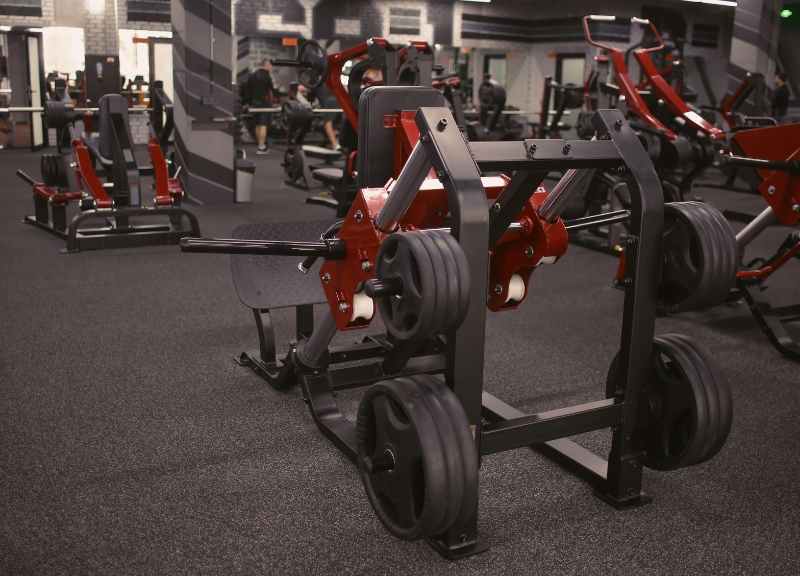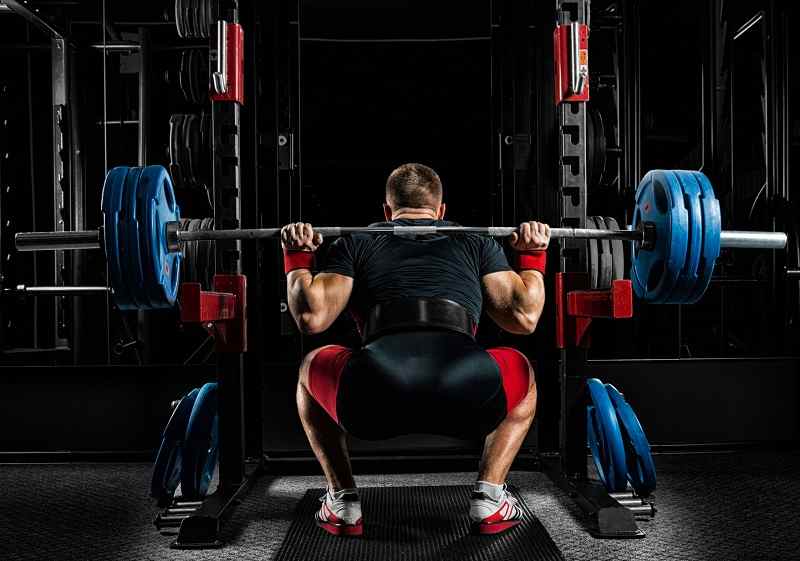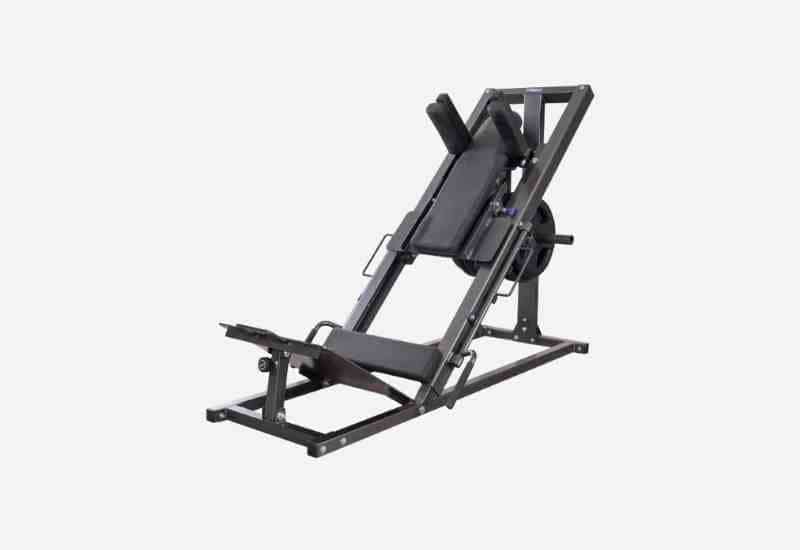Squats are king when it comes to lower body muscle and strength. In this guide, we look at the differences between the hack squat and the traditional back squat, including the benefits, disadvantages of each, and more.

The hack squat is one of the most popular machine-based lower body exercises, thanks to the fact that it isolates your leg muscles and maximizes quad engagement.
But how does it compare to regular squats? Is it worth training on the hack squat machine, or are you better off with free weights?
In this post, we intend to find out!
Below, we’ll take a deep dive into hack squats, compare them to back squats, and find whether the differences between the two exercises make one better than the other.
(Read our hack squat vs leg press article for a comparison between two machine-based exercises.)
By the end of this post, you’ll know which exercise you should prioritize in your training sessions.
Let’s jump right in.
Hack Squat – Overview
Let’s start off by talking about the machine-based option. Because it’s one you need a specific piece of equipment for, it’s one you have to do at the gym (unless you have a hack squat machine at home).
The hack squats use a machine that features an angled sliding track, a platform to stand on, and a padded bar that rests on your shoulders.

When you squat, your knees track forward over your toes, maximizing the focus on your quads.
The fact that hack squats are so quad-focused are definitely one of their main benefits. You can isolate your thigh muscles and really maximize hypertrophy in a way that back squats just can’t.
If your goal is building raw power and strength, hack squats are a beast of an exercise!
Back Squat – Overview
The back squat, as we all know, is a free weight-based exercise that involves squatting with a barbell resting on your shoulders. Step into a squat rack, load it with plates, and go to work.
Your core engages to stay balanced as you go through the squatting motion, and there is greater recruitment of secondary muscles (including the hamstrings, glutes, and hips) throughout the exercise.

However, the focus is still chiefly on the quads, which makes them an excellent choice for building monster leg muscles!
The Differences Between Hack Squat vs Back Squats
The two exercises are fundamentally the same—you’re squatting carrying weight on your upper back—but because one is machine-based and the other utilizes free weights, there are a few significant differences between them.
Difference 1: Freedom of Movement
I’m always in favor of exercises that allow you to move naturally and smoothly, with as few restrictions on your motion as possible. This is one reason that I typically prefer free weight exercises over machine-based exercises.
With a hack squat, the machine restricts your movement to only up/down along the track. This is great for safety and stability (as I explain below).
However, if you’ve got limitations on your movement—for example, after an injury or surgery, or due to reduced mobility/flexibility—the restricted movement of a hack squat can actually place greater strain on your joints.
Back squats, like all free weight exercises, are free of any restrictions.
You can squat using the form/posture that feels most natural to you, allowing you to move the “right” way according to your specific joint/muscular limitations and capabilities.
Difference 2: Muscle Isolation
A lot of hardcore weight trainees want to isolate their quad muscles because it allows them to max out hypertrophy and increase muscular growth. If your goal is to really focus on your quads, hack squats are the better choice for you.
On the other hand, muscle isolation doesn’t necessarily translate into better strength or force generation overall. Sure, your quads will be able to produce massive amounts of power, but only in that specific position/range of motion.
If your posture changes even slightly, the muscles that work together with your quads just won’t have enough power.
That’s where muscle isolation exercises often lead to wider-spread deficiencies in both strength and stability.

Exercises like back squats that force your body to compensate for instability by increasing muscular force generation in both the prime movers (quads) and secondary and stabilizer muscles (including your glutes, hips, hamstrings, and core) tend to make you overall stronger and more resilient.
Your body is capable of generating more force in a variety of positions/ranges of motion because all of the muscles that support the prime movers are being worked, too.
Difference 3: Knee Strain
One of the biggest downsides of hack squats is the strain that they place on your knees.
When you’re standing on that hack squat platform with your feet planted in front of you, you’re already pressing forward and pushing your thigh bones against the knee joint.
Now go down into the squat, and it’s more akin to a wall squat (pressing against the knees at a 90-degree angle) than a regular squat (with the hip hinging to keep your center of gravity over the knees).
7 Benefits of Hack Squats (Plus Disadvantages, Muscles Worked, Form Tips). The hack squat is a killer squat variation for lifters who want to take leg day to the next level. Here’s a complete guide to the benefits, muscles worked, and form tips for the hack squat.
While this is great for strengthening the VMOs (muscles directly around the knees), it can also lead to a higher risk of knee strain.
Back squats place a lot less pressure on your knees, and through the full range of motion, your knee joints are better-supported by your leg muscles. For those with knee issues, back squats are the safer choice by a margin.
Difference 4: Lower Back Engagement
Now it’s time to talk about one of the biggest downsides of back squats: a higher risk of lower back strain.
You see, with the barbell loaded on your shoulders and no additional support, your core has to engage throughout the full range of squat motion.
While this is great for building a solid, stable core, there’s always the risk that poor posture/form can add excess strain on your lower back, leading to a higher risk of spinal muscle injuries.
Hack squats, on the other hand, involve no lower back engagement at all. In fact, your core is essentially unused because the sliding rail keeps everything nice and stable.
All of the focus is directly on your legs, making it much safer for anyone with lower back injuries.
Difference 5: Difficulty
Squats are one of the first exercises that beginners have to master, because they’re the most effective for building better overall lower body strength.
However, it can take months of regular squatting to get the back squat form just right, and even the slightest change to your musculoskeletal structure (including injuries, reduced flexibility, and muscular imbalances) can cause that “correct” posture/form to change.
On the other hand, there’s a lot less challenge to mastering the hack squat. There’s no need to pay much attention to what your upper body is doing during the squat, because the machine is basically removing your upper body from the equation.
Related: Wondering what the best foot placement on the hack squat machine is? Here’s a detailed look at the seven hack squat foot placements and the benefits of each.
All you have to do is focus on your legs—from your foot placement to the way your knees track over your toes to how deep into the squat you go.
Simply put: hack squats are easier to master than back squats, making them a much better choice for gym newbies who are looking to step up their lower body training game.
Difference 6: Safety
With a back squat, you’re carrying all the weight on your upper back/shoulders, and all you have for support is the squat cage.
You’re likely going to need a spotter to help you safely squat, especially if you’re maxing out on the weight.
If you’re a solo trainee and there are no trainers around to help you, there’s a risk that you’ll hit failure on the last reps and struggle to push back up, or you could even tip/fall over if you’re off-balance because of the heavy weight.
Related: Want to simulate the hack squat but don’t have access to a hack squat machine? Here’s a look at my favorite hack squat alternatives that you can do at the gym or at home.
However, because the hack squat uses a machine, there’s no need for a spotter. Sure, you might need help completing those last few reps if you’ve really loaded up the bar.
There’s no real risk that you’ll fall/tip over/lose your balance, though, because there’s only one direction the weight can move: along the fixed track.
This makes it slightly safer for newbies and those who train heavy without a lifting partner/spotter.
Difference 7: Practicality
One of the primary reasons people can’t do hack squats at home is because they don’t have/have space for a hack squat machine.
It’s a big, heavy machine that takes up a lot of space, and it can only be used for hack squats. Compare it to far more versatile machines—like the squat cage or cable machine, for example—and it’s just not the most practical choice for home gyms.
For back squats, all you really need is a barbell and some weight plates, and you’re good to go!
Most gyms will have at least one hack squat machine, though, so it’s a great option to include in your routine if you’re working out at a gym rather than at home.
Hack Squat vs Back Squat – FAQs
Should I do hack squats and back squats on the same day?
Absolutely! Think of back squats (and front squats) as the “starter” exercise, the perfect way to begin your lower body training session that focuses on all of the muscles—both prime movers and secondary and stabilizer muscles—that allow you to squat properly.
Once you’ve hit a few sets of this more broadly-focused exercise, you can zero in on your quads and isolate them using hack squats.
It’s a killer combination guaranteed to max our hypertrophy and help you build those thick, powerful legs you want.
Can I replace squats with hack squats?
Technically, you can perform only hack squats in your lower body workout sessions. Because they are squats, they pay the right kind of attention to your quads and develop power in these crucial leg muscles.
However, if you’re replacing regular squats with hack squats, I recommend that you include other leg exercises that hit your lower body overall (not just your quads, but your hamstrings, glutes, and hips, too).
For example, lunges, goblet squats, or jump squats will all help to develop better overall leg strength, rather than just isolating your quads.
The Bottom Line
Hack squats are an awesome exercise to target your legs and build serious power. The fact that they isolate your quads means that they focus chiefly on the largest and most powerful of your leg muscles, which generate the majority of force in most lower body exercises.
Take note, though: they isolate your quads, which means your other leg muscles will need to be trained, too, the way they would if you did back squats, front squats, or pretty much any non-machine-based squats.
While both exercises are excellent for your legs, you should use back squats to start your workout off (for broader focus and better overall strength) and hack squats as the finisher to max out quad power!